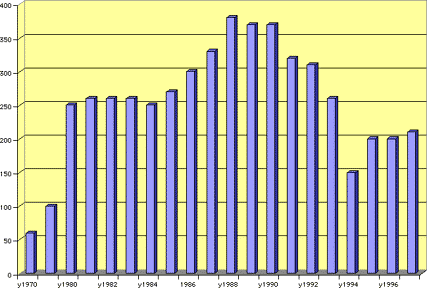|

RWANDA
Economy
GDP (2008 est.): $9.06 billion.
Real GDP growth rate (2008 est.): 7.5%.
Per capita income (2008 est.): $900.
Average inflation rate (2000 est.): 3
Budget: Income ............... $902 million
Expenditure .... $1.03 million
Main Crops: Coffee, tea, pyrethrum (insecticide made from chrysanthemums), bananas, beans, sorghum, potatoes; livestock .
Natural Resources: Gold, cassiterite (tin ore), wolframite (tungsten ore), methane, hydropower .
Major Industries: Production of cement, processing of agricultural products, small-scale beverage production, manufacture of soap, furniture, shoes, plastic goods, textiles, cigarettes .
|
| NATIONAL GNP |
 |
The Rwandan economy is based on the largely rainfed agricultural production of small, semisubsistence, and increasingly fragmented farms. It has few natural resources to exploit and a small, uncompetitive industrial sector. While the production of coffee and tea is well-suited to the small farms, steep slopes, and cool climates of Rwanda, farm size continues to decrease, especially in view of government ownership of all land and the resettlement of displaced persons. Agribusiness accounts for 50% of Rwanda’s GDP and 70% of exports. Tea accounts for 60% of export earnings, followed by coffee and pyrethrum (whose extract is used in insect repellant). Mountain gorillas serve as a potentially important source of tourism revenue, but Rwanda’s tourism and hospitality sector requires further development. Rwanda is one of 20 member states of the Common Market for Eastern and Southern Africa (COMESA) and hoped to form a free trade area with Burundi in January 2004. Some 34% of Rwanda’s imports originate in Africa, 90% from COMESA countries. The genocide continues to impact Rwanda’s economy; as of 2003, 30% of the Rwanda Development Bank’s outstanding nonperforming loans originated from the period of 1994 genocide. In 2003, the Government of Rwanda sought to privatize several key firms, including Rwandatel (the country’s second-largest mobile phone provider); Electrogaz, the utility monopoly; several government-owned tea factories; and the Commercial Bank of Rwanda, the country’s second-largest commercial bank.
During the 5 years of civil war that culminated in the 1994 genocide, GDP declined in 3 out of 5 years, posting a dramatic decline at more than 40% in 1994, the year of the genocide. The 9% increase in real GDP for 1995, the first postwar year, signaled the resurgence of economic activity, due primarily to massive foreign aid.
In the immediate postwar period--mid-1994 through 1995--emergency humanitarian assistance of more than $307.4 million was largely directed to relief efforts in Rwanda and in the refugee camps in neighboring countries where Rwandans fled during the war. In 1996, humanitarian relief aid began to shift to reconstruction and development assistance.
Since 1996, Rwanda has experienced steady economic recovery, thanks to foreign aid (averaging $200-$300 million per year) and governmental reforms. As of 2002, the GDP had ranged from 3%-9% per annum, and inflation had ranged between 2%-3%. Rwanda depends on significant foreign imports ($250-$300 million per year). Export rates remain weak at $75 million per year. Private investment remains below expectations despite an open trade policy, a favorable investment climate, cheap and abundant labor, tax incentives to businesses, stable internal security, and crime rates that are comparatively low. Investment insurance also is available through the Africa Trade Insurance Agency or the Overseas Private Investment Corporation. The weakness of exports as well as low domestic savings rates have had a negative impact on the current account for Rwanda, thus requiring a recent currency devaluation and debt restructuring measures.
The Government of Rwanda remains committed to a strong and enduring economic climate for the country. To this end the government focuses on poverty reduction, infrastructure development, privatization of government-owned assets, expansion of the export base, and liberalization of trade. The implementation of a value added tax of 18% and improved tax collections are having a positive impact on government revenues and thereby services rendered. Banking reform and low corruption also are favorable current trends. Agricultural reforms, improved farming methods, and increased use of fertilizers are improving crop yields and national food supply. Moreover, the government is pursing educational and healthcare programs that bode well for the long-term quality of Rwanda’s human resource skills base.
Many challenges remain for Rwanda. Rwanda is dependent on significant foreign aid. Exports continue to lag far behind imports and will continue to affect the current account. Inflation may become a problem should the government resort to over-printing currency for short-term gains. The persistent lack of economic diversification beyond the production of tea, coffee, and coltan keeps the country vulnerable to market fluctuations. Rwanda’s landlocked situation necessitates strong highway infrastructure maintenance, and good transport linkages to neighboring countries, especially Uganda and Tanzania, are critical. Transportation costs remain high and, therefore, burden import and export costs. Rwanda has no railway system for port access in Tanzania, although the nearest railhead from Kigali is 380 kilometers away at Isaka, Tanzania. The development of small manufacturing and service industries is needed, and the tourism industry, now at 8,000 visitors per year, has far greater potential given the current stability, travel infrastructure, and available animal parks as well as other potential tourist sites.
American business interest in Rwanda, other than in tea and telecommunications, is weak, and the African Growth and Opportunity Act (AGOA) has yet to make a significant impact in Rwanda. Energy needs will stress natural resources in wood and gas, but hydroelectric power development is underway, albeit primarily in the planning stages. Rwanda does not have nuclear power nor coal resources. Finally, the Rwanda’s fertility rate (averaging 5.8 births per woman) will continue to stress services, and diseases such as AIDS/HIV transmission, malaria, and tuberculosis will have a major impact on human resources.
Rwanda's government-run radio broadcasts 15 hours a day in English, French, and Kinyarwanda, the national languages. News programs include regular re-broadcasts from international radio such as Voice of America and Radio France International. There is a fledgling television station. There are few independent newspapers; most newspapers publish in Kinyarwanda on a weekly, biweekly, or monthly basis. Several Western nations, including the United States, are working to encourage freedom of the press, the free exchange of ideas, and responsible journalism. |
|
|


